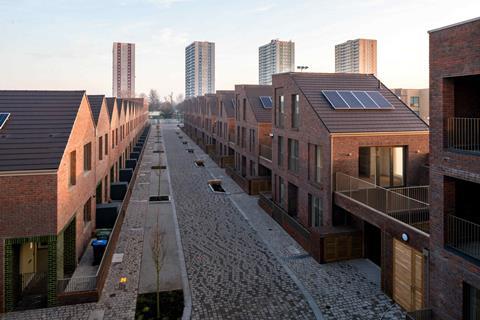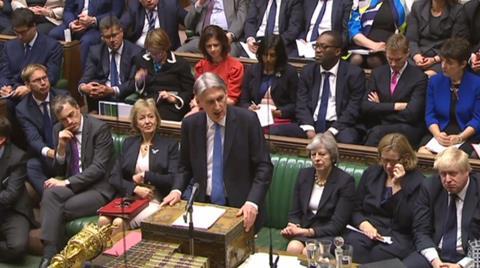Government-funded social-rent completions fall to record low of 173

Architects have warned that the government needs to match the chancellor’s pro-housing words in the budget with action in the light of damning new figures from the Homes and Communities Agency.
Just 173 social rent properties were completed as part of HCA-supported programmes in the six months to September 30 – the lowest figure on record for the organisation.
That is a 75% year-on-year drop, according to the latest data from the official delivery body which is tasked with driving growth in new homes.
Figures detailing starts on site between April and September also showed a 24% decline in the number of homes categorisable as “affordable” compared with the same period in 2016 – 7,082 against 9,344.
The figures relate only to England, and do not include government-funded housing-delivery programmes in London, which are now the responsibility of the capital’s mayor. Nor do they include local authority-funded social rent schemes.
Nevertheless, the HCA is the government’s main channel for investing in the delivery of new affordable homes, and the numbers have provoked alarm in the architecture profession and allowed Labour housing spokesman John Healey to describe the rate at which new social-rent homes were delivered by the organisation as “shocking”.
RIBA president Ben Derbyshire was more measured in his observations but said the numbers betrayed the magnitude of the step-change required of Westminster if it is to reach the 300,000-homes-a-year target identified by chancellor Philip Hammond in last month’s “housing budget”.
“These figures are another indication of just how far we need to go to tackle the housing crisis and, in particular, to address the catastrophic lack of social housing,” he said.

“We need to see a much greater focus across government to meet the scale of the challenge, for example an end to the delay in lifting housing borrowing caps for councils until 2019-20.”
Brendan Kilpatrick, senior partner at PRP Architects, laid the blame for the latest figures squarely at the feet of former chancellor George Osborne and his July 2015 announcement of a year-on-year reduction in rent levels that housing associations can charge their tenants, placing an additional squeeze on the viability of social rent new-build.
“In response, housing associations have successfully altered their business models and most have heavily diversified into building more shared-ownership homes and some have become significant developers of private housing,” he said.
“Many have also moved – or are moving – into the build-to-rent sector. Overall output for many housing associations has increased, but this is generally at the expense of truly affordable housing.”
Kilpatrick said the impact on government-funded programmes to build homes for those most in need was “stark”.
He added: “[The figure] also suggests that housing association surpluses, one of the reasons for the government onslaught in the first place, are being channelled into various forms of affordable and ‘less affordable’ products but that social rent as a sub-sector is diminishing and will continue to do so.”
John Healey – who served as a housing minister in the final months of Gordon Brown’s Labour administration – said the latest figures for HCA-related social-rent completions represented just 2% of the level in April-September 2009, his party’s most recent comparable period in power.
“After seven years of Tory failure on housing, homelessness has doubled, home-ownership has fallen to a 30-year low and the number of new genuinely affordable homes being built has fallen off a cliff,” he said.
However, while HCA figures for April-September 2009 confirm that there were 8,828 social-rent completions in that quarter, there were no completions recorded in the “affordable rent” category – which accounted for 7,213 starts in the latest figures.
Nevertheless, the latest figures show 9,281 affordable completions for the April-September period in 2017, against 15,040 in the same period in 2009.
Social rented housing is the cheapest sub-category of “affordable” housing and equates to the rent levels typically charged to council tenants. Affordable rent, meanwhile, can be up to 80% of market rates.
The HCA’s total affordable home completion figures also include so-called “intermediate affordable housing”, such as properties built for shared-ownership or rent-to-buy schemes.
Figures released by the Department for Communities and Local Government said 217,350 new homes were created in the year to April, a 15% increase on 2015-16.
A breakdown showed 183,570 of the properties were new-builds, while the remaining new homes resulted from conversions, changes of use, and other gains such as “caravans” and “houseboats”.
DCLG said 41,530 affordable homes were delivered in England in 2016-17, of which 5,380 were for social rent.
The provision of new social-rent homes has been in decline since 2010-11, when 39,560 such homes were delivered. The most recent peak in output for affordable housing was 2014-15, when 66,700 such homes were delivered – included in which figure were 9,570 social-rent homes.
The HCA said the 24% decline in affordable starts reflected a “challenging operating environment” but insisted the issue had “been addressed by recent government action” such as the post-2020 rent settlement for housing associations.
Chief executive Nick Walkley said November’s budget had given him confidence that the agency would increase housing supply over the long term.
“The delivery of affordable homes is steadily increasing but we know that we need to do more,” he said.














1 Readers' comment